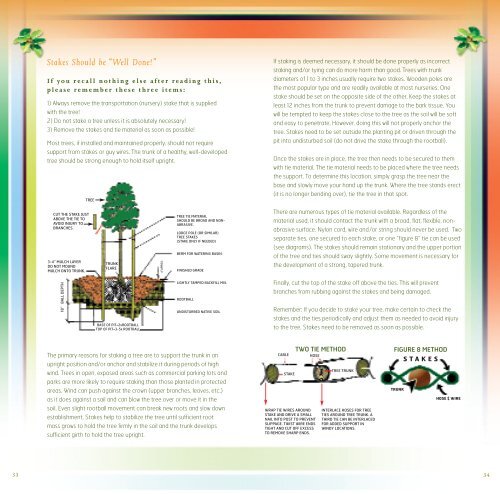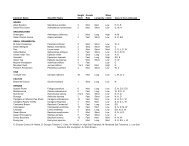trees for Tomorrow.pdf - Nevada Division of Forestry
trees for Tomorrow.pdf - Nevada Division of Forestry
trees for Tomorrow.pdf - Nevada Division of Forestry
Create successful ePaper yourself
Turn your PDF publications into a flip-book with our unique Google optimized e-Paper software.
Stakes Should be “Well Done!”<br />
If you recall nothing else after reading this,<br />
please remember these three items:<br />
1) Always remove the transportation (nursery) stake that is supplied<br />
with the tree!<br />
2) Do not stake a tree unless it is absolutely necessary!<br />
3) Remove the stakes and tie material as soon as possible!<br />
Most <strong>trees</strong>, if installed and maintained properly, should not require<br />
support from stakes or guy wires. The trunk <strong>of</strong> a healthy, well-developed<br />
tree should be strong enough to hold itself upright.<br />
CUT THE STAKE JUST<br />
ABOVE THE TIE TO<br />
AVOID INJURY TO<br />
BRANCHES.<br />
3-4” MULCH LAYER<br />
DO NOT MOUND<br />
MULCH ONTO TRUNK.<br />
18” BALL DEPTH<br />
TREE<br />
TRUNK<br />
FLARE<br />
BASE OF PIT=2xROOTBALL<br />
TOP OF PIT=3-5x ROOTBALL<br />
The primary reasons <strong>for</strong> staking a tree are to support the trunk in an<br />
upright position and/or anchor and stabilize it during periods <strong>of</strong> high<br />
wind. Trees in open, exposed areas such as commercial parking lots and<br />
parks are more likely to require staking than those planted in protected<br />
areas. Wind can push against the crown (upper branches, leaves, etc.)<br />
as it does against a sail and can blow the tree over or move it in the<br />
soil. Even slight rootball movement can break new roots and slow down<br />
establishment. Stakes help to stabilize the tree until sufficient root<br />
mass grows to hold the tree firmly in the soil and the trunk develops<br />
sufficient girth to hold the tree upright.<br />
4”APROX.<br />
TREE TIE MATERIAL<br />
SHOULD BE BROAD AND NON-<br />
ABRASIVE.<br />
LODGE POLE (OR SIMILAR)<br />
TREE STAKES<br />
(STAKE ONLY IF NEEDED)<br />
BERM FOR WATERING BASIN.<br />
FINISHED GRADE<br />
LIGHTLY TAMPED BACKFILL MIX.<br />
ROOTBALL<br />
UNDISTURBED NATIVE SOIL<br />
If staking is deemed necessary, it should be done properly as incorrect<br />
staking and/or tying can do more harm than good. Trees with trunk<br />
diameters <strong>of</strong> 1 to 3 inches usually require two stakes. Wooden poles are<br />
the most popular type and are readily available at most nurseries. One<br />
stake should be set on the opposite side <strong>of</strong> the other. Keep the stakes at<br />
least 12 inches from the trunk to prevent damage to the bark tissue. You<br />
will be tempted to keep the stakes close to the tree as the soil will be s<strong>of</strong>t<br />
and easy to penetrate. However, doing this will not properly anchor the<br />
tree. Stakes need to be set outside the planting pit or driven through the<br />
pit into undisturbed soil (do not drive the stake through the rootball).<br />
Once the stakes are in place, the tree then needs to be secured to them<br />
with tie material. The tie material needs to be placed where the tree needs<br />
the support. To determine this location, simply grasp the tree near the<br />
base and slowly move your hand up the trunk. Where the tree stands erect<br />
(it is no longer bending over), tie the tree in that spot.<br />
There are numerous types <strong>of</strong> tie material available. Regardless <strong>of</strong> the<br />
material used, it should contact the trunk with a broad, flat, flexible, nonabrasive<br />
surface. Nylon cord, wire and /or string should never be used. Two<br />
separate ties, one secured to each stake, or one “figure 8” tie can be used<br />
(see diagrams). The stakes should remain stationary and the upper portion<br />
<strong>of</strong> the tree and ties should sway slightly. Some movement is necessary <strong>for</strong><br />
the development <strong>of</strong> a strong, tapered trunk.<br />
Finally, cut the top <strong>of</strong> the stake <strong>of</strong>f above the ties. This will prevent<br />
branches from rubbing against the stakes and being damaged.<br />
Remember: If you decide to stake your tree, make certain to check the<br />
stakes and the ties periodically and adjust them as needed to avoid injury<br />
to the tree. Stakes need to be removed as soon as possible.<br />
WRAP TIE WIRES AROUND<br />
STAKE AND DRIVE A SMALL<br />
NAIL INTO POST TO PREVENT<br />
SLIPPAGE. TWIST WIRE ENDS<br />
TIGHT AND CUT OFF EXCESS<br />
TO REMOVE SHARP ENDS.<br />
TWO TIE METHOD FIGURE 8 METHOD<br />
INTERLACE HOSES FOR TREE<br />
TIES AROUND TREE TRUNK. A<br />
THIRD TIE CAN BE INTERLACED<br />
FOR ADDED SUPPORT IN<br />
WINDY LOCATIONS.<br />
STAKES<br />
33 34<br />
CABLE<br />
STAKE<br />
HOSE<br />
TREE TRUNK<br />
TRUNK<br />
HOSE & WIRE



